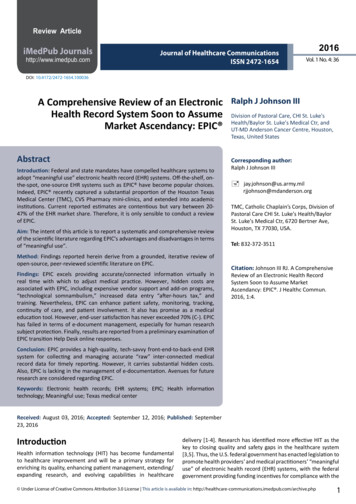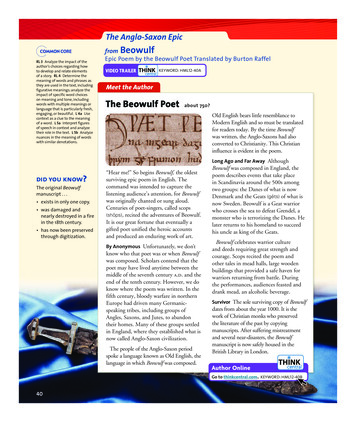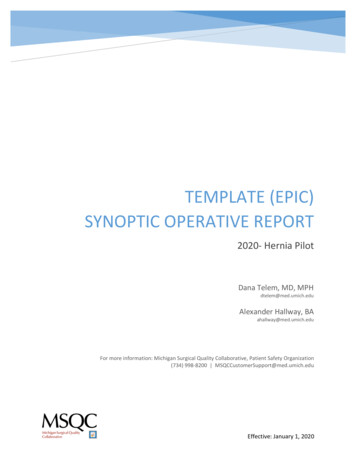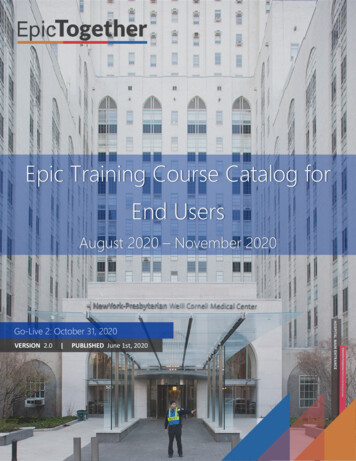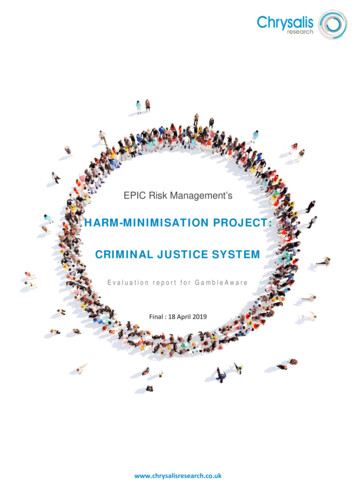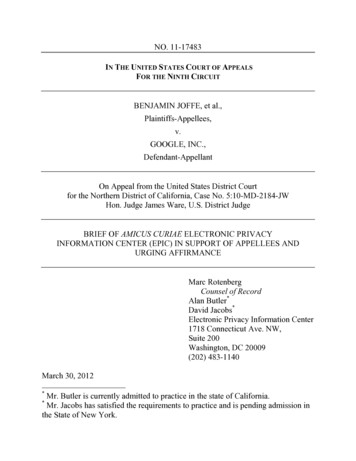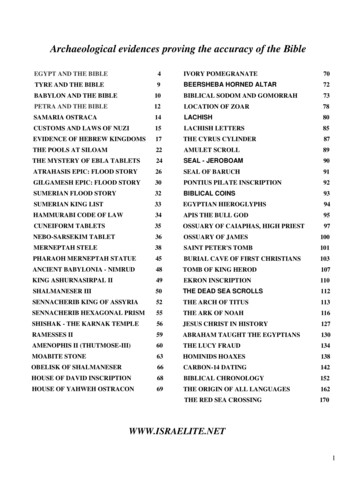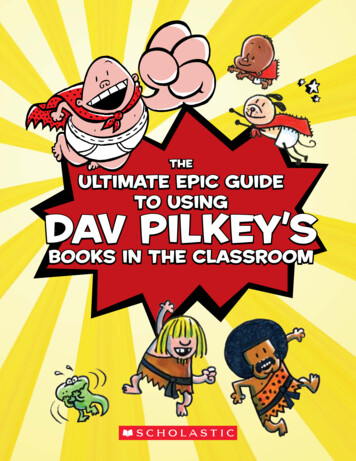
Transcription
TheULTIMATE Epic Guideto UsingDav Pilkey’sBooks in the Classroom
WARNING!Dav Pilkey’s books have been known to be devoured by children aged seven toone hundred years old. Even the most reluctant readers just can’t seem to getenough of that wedgie-wielding superhero, Captain Underpants! And then thereare those riveting graphic novels by George Beard and Harold Hutchins, TheAdventures of Ook and Gluk, Kung-Fu Cavemen from the Future; The Adventures ofSuper Diaper Baby; and its sequel, Super Diaper Baby 2: The Invasion of the PottySnatchers.This guide is designed for teachers who have desperately tried to pry Dav Pilkey’sbooks from the hands of students during math, social studies, and sciencelessons. It is based on the radical concept that, hey, maybe the students who lovethese books so much might actually be learning something from them! Includedyou will find ideas for use in the classroom that will enrich your curriculum andcreate outrageous amounts of fun and learning.
“Encourage kids to be creative withoutworrying about being perfect.”Dear Teachers,When I was a kid, I loved to draw and make up stories. I didn’t worry about drawingthings perfectly or spelling things correctly. I just wanted to get my ideas andstories on paper. I loved the freedom that came with creating stories just for fun.Once I got published, I spent years traveling to different schools and talking withkids about my books. During these school visits, I was surprised to learn that mostkids didn’t consider themselves to be artists or writers. Most kids thought theyhad to be able to draw Garfield perfectly to be an artist. They had also convincedthemselves that they needed to spell perfectly in order to be writers. Everywhere Iwent, I met kids who were stifled creatively because of their fears of imperfection.My goal at these school visits was to encourage kids to be creative withoutworrying about being perfect. I showed kids examples of Impressionists who drewhouses upside down, painted freely, and broke all the rules. Much to the dismay ofthe teachers in the room, I also gave examples of famous writers and poets whodidn’t use conventional spelling, grammar, and punctuation. I think the kids I spokewith were inspired by these examples, but I wanted to reach more kids, all overthe world.That’s how Captain Underpants came along. I designed each book to contain twoor three “mini-comics” which were created by the stories’ protagonists, GeorgeBeard and Harold Hutchins. George and Harold’s simple, silly, and wildly imperfectmini-comics turned out to be one of the most popular parts of each book. My hopewas that George and Harold’s “imperfect examples” would give kids permission toinvent their own stories without concern for perfectionism, and so far, it seems tohave worked. Every year, I get hundreds of original comics and stories mailed tome from kids. These kids didn’t make their comics because of a school assignment.None of these stories were proofread or graded or marked up with a red pen. Thesestories were all made for one reason—for fun!And isn’t that what creativity is all about?
PART 1: A General Guide to UsingDav Pilkey’s Books in the ClassroomDav Pilkey’s books are jam-packed with sidesplitting humor and fast-paced action. Hischaracters come alive and engage the reader from beginning to end. Use your students’enthusiasm for Pilkey’s books to enrich your language arts curriculum.Exploring Character TraitsGeorge Beard and Harold Hutchins, two outrageously mischievous, creative, comic bookwriting fourth graders from the hilarious Captain Underpantsseries, are certain to inspire your students to want to becomeauthors and illustrators of their own comic book adventures.Encourage your students to create an original superhero. Explorethe qualities that define a superhero. Work with your studentsto brainstorm a list of character traits they feel would be essentialfor a superhero to possess. You may want to start them off witha few examples, such as, brave, confident, daring, imaginative, strong,etc. Post your list and have students add to it as they discover newword choices.Once your list has been established, encourage your students to write a story about theirsuperhero. Suggest that the superhero act in ways that demonstrate the character traits he/she may possess. Have your students create an illustration of their superhero to go along withtheir stories.Using Descriptive LanguageAction and adventure are essential elements of Dav Pilkey’s books. They provide the teacherand the student with a wonderful opportunity to explore the use of powerful verbs anddescriptive language.Have your students work cooperatively to find and list the verbs found in pre-selectedsections of Dav Pilkey’s books. They will see that their lists will soon begin to contain wordssuch as demanded, shouted, screamed, whimpered, cried, and laughed. Discuss how these wordshelp Pilkey’s stories come alive and how important word choice is to good writing. Ask yourstudents to write a conversation between two characters using these vivid verbs.Demonstrate the correct use of punctuation when writing dialogue: quotation marks,commas, periods, question marks, and exclamation marks.
Introducing Graphic NovelsIntroduce your students to the format of graphic novels, which are stories written andillustrated in the style of comic books. Use a Venn diagram to compare and contrast graphicnovels with chapter books. What do your students notice that these formats have incommon? What are some of the differences? Generate a conversation regarding the elementsof graphic novels. For example, the pictures and narrative tell a sequential story. Quotationmarks are not necessary because the dialogue appears in speech FERENTChallenge your students to create an original comic strip. Remind them that it is easier towrite the dialogue first and then enclose it in a speech bubble!Writing a Friendly LetterHelp improve your students’ persuasive letter-writing skills by having them write to theirfavorite Dav Pilkey character! Who will they choose? Will it be Captain Underpants,George, Harold, or maybe even mean Mr. Krupp?!Begin by reviewing the five parts of a friendly letter: the heading, greeting, body, closing,and signature. Then have your students try to persuade their favorite character to come visittheir school. Encourage your students to be clear about the benefits of visiting the schoolfrom the character’s point of view.For example, a student may appeal to George and Harold by stating that the principalof their school is fair and open-minded (unlike mean old Mr. Krupp), and that he/sheenjoys creative children. Therefore, visiting their school would be a pleasant and enjoyableexperience for George and Harold.Infusing Spelling InstructionWhile George and Harold are clearly creative, they could certainly use some help with theirspelling. Borrow time from formal spelling instruction by integrating spelling training withwriting. Challenge your students to use their weekly spelling lists to find and correct theerrors found in George and Harold’s comics.
Part 2: A Guide to using the twolatest Captain Underpants books inthe classroomCaptain Underpants and the Terrifying Returnof Tippy TinkletrousersQuick! Grab your red cape! It’s here the moment Captain Underpants fans have beenwaiting for. George Beard and Harold Hutchins are finally back in kindergarten!!!! Yes,Captain Underpants and the Terrifying Return of Tippy Tinkletrousers transports us backin time to the beginning of George and Harold’s budding friendship.Since George and Harold don’t actually invent Captain Underpants until fourth grade, thetwo clever kindergartners have only their own brainpower to rely on, as they prepare tobattle the bullies at Jerome Horowitz Elementary School. Your students will howl at thehilarious antics of George and Harold as they toil together to defeat the despicable KipperKrupp—nephew of the clueless school principal—and his cronies. After all, everyone knowsit takes brains, not brawn, to beat a bully.CREATE A BULLY-FREE CLASSROOMBest buddies George Beard and Harold Hutchins are not about to let the bullies at JeromeHorowitz Elementary School steal their lunch money and make their lives miserable!They know the best way to deal with a bully is to use your wits, not your mitts! Help yourstudents feel safe, and provide a welcome place of learning with the help of these simple bullyprevention activities.Be Direct—Define BullyingLead your students in a discussion about the types of bullying they are most likely toencounter in school: physical, emotional, and verbal. Physical bullying involves hitting, pushing, kicking; any unwanted physical contact. Emotional bullying is bullying that may cause damage to a person’s emotionalwell-being. Making fun of others, purposely excluding others from activities, andspreading rumors are all examples of emotional bullying. Verbal bullying is bullying that causes emotional distress due to slanderouscomments. Name calling and negatively commenting on someone’s looks, clothes, oractions are examples of verbal bullying.Create an anchor chart that clearly illustrates the types of bullying elementary schoolchildren encounter most often and display it in your classroom. Refer to it throughoutthe year as needed to help your students understand and recognize common forms ofbullying.
Pledge To Be Bully FreeEmpower your students! Work togetherto create a “bully-free” pledge. The pledgeshould be comprised of a few key phrasesyour students can easily remember to helpthem handle bullying.Have your students take ownership ofthe pledge by signing their names on thedocument. Proudly display the pledge justoutside your classroom door. Teachers,administrators, and students throughoutyour school will have no doubt that they areentering a bully-free zone every time theywalk through the doors of your classroom!YOU ARE ENTERINGA BULLY-FREE ZONE!We, the undersigned,promise to: treat everyone with respect and kindness be a good role model to younger children reach out to others who are bullied;be a friend go for help when I see someone being bullied s tand up for myself and others I won’t standby and watch someone else being bulliedA RECIPE FOR FRIENDSHIPGeorge and Harold have the perfect recipefor friendship. A cup of cooperation, asmidge of smarts, a gallon of good ideas, anda whole lot of humor combine to make themfriends for life!Signed:Have your students write a “Friendship Recipe.” Their recipe should include the mostimportant “ingredients” of a friendship. Is it kindness, respect, cooperation? What reallygoes into a friendship?Once your students have settled on their ingredients, remind them that a good cookcombines ingredients in a special way to create the perfect dish. Have them explain howthey would combine their ingredients to become a good friend.Advanced chefs may wish to go beyond the basic recipe and provide step-by-step directionsfor making new friends.This is an activity you and your students are sure to eat up!WRITING BUDDIESGeorge and Harold, the daring duo from Jerome Horowitz Elementary School, findthemselves unjustly imprisoned in detention for defending themselves against a pack ofbrutish bullies. Are they disconcerted, discouraged, depressed? No way! They make the bestof a bad situation, combine their creative talents, and lo and behold, Tree House Comix, Inc. isborn!Motivate your students to explore their own creativity. Create “Writing Buddies” by pairingstudents together. Encourage them to write in the style of George and Harold!
Have your students create original comic books. As one student in the pair writes the copyfor an original comic book, the other student can create the illustrations. You can be surethat once you start this writing buddy activity the partners will want to switch roles. Whata great opportunity to create a sequel for the original comic book! Be sure to have plenty ofpencils and paper on hand. And make room on your bookshelves! Your class library is aboutto explode with hundreds of hilarious pages of original comics.AWESOME ALLITERATIONChallenge your students to find examples of alliteration in Captain Underpants and theTerrifying Return of Tippy Tinkletrousers. Remind them that alliteration is simply when two ormore nearby words have the same beginning sound—like in the title of the story!Some great examples of alliteration can be found on the following pages of CaptainUnderpants and the Terrifying Return of Tippy Tinkletrousers.p. 4ı “I’m going to put an end to that nonsensical nuisance, Captain Underpants!”p. 68 “ He ducked his head beneath the cockpit of the Robo-Suit and disappeared down astairwell into the intricate innards of his intimidating invention.”TOTALLY TERRIFIC TONGUE TWISTERSYour students will have a blast building their own tongue twisters! Here’s how:ı. Have each student write his/her name on a strip of paper and ask them to place thepaper into a large container; a big shopping bag works well.2. Shake up the shopping bag and give each child a name strip, making sure no onegets their own name. Students create a tongue twister about the person whose nameappears on the paper strip they received.3. To make it a bit easier, you can have your students fold a piece of paper into fourcolumns, lengthwise. They can label each column with the following parts of speech:nouns, adjectives, verbs, and adverbs. Students can use this paper to help them organizetheir word choices. Remind students that they should only say nice things about theirclassmates!4. Keep a supply of dictionaries and thesauruses nearby; they are sure to be well usedduring this activity.Students can illustrate their finished tongue twisters. Completed creations are sure tobecome a totally terrific bulletin board!
Captain Underpants and the Revolting Revengeof the Radioactive Robo-BoxersTippy Tinkletrousers continues to cause trouble for George Beard and Harold Hutchinswith his time-traveling antics in Captain Underpants and the Revolting Revenge of theRadioactive Robo-Boxers. Join George, Harold, Crackers, and Sulu as they pile into thePurple Potty, and travel back in time in an attempt to outrun Tippy Tinkletrousers and hisice-blasting Freezy-Beam 4000! Will they be able to save the planet? More importantly, willthey be able to save Captain Underpants?!Luckily, the Purple Potty placed George, Harold, Crackers, Sulu, and Mr. Krupp er,Captain Underpants right in the middle of the Cretaceous period! But time flies whenyou’re having fun, or being chased by an evil villain! Before you know it, George, Harold,Sulu, Crackers, and Captain Underpants zip through the Cenozoic era straight into thePleistocene epoch.CAVE PAINTINGSIt’s a good thing George and Harold put their heads together and decided to draw Tippy andhis big ol’ Robo-Pants on the cave wall. How else would they have been able to get the cavepeople to help them defeat their evil nemesis?Explain to your students that cave paintings are most often found on cave walls and ceilings,especially the paintings of prehistoric times. While no one can truly be certain of the exactpurpose of the paintings, it is believed that they were not just used for decorative purposes,but also as a way of communicating with others. Some cave paintings may have had areligious or ceremonial purpose.Create a Cave PaintingHave your students follow these steps to create their own “cave painting.”ı. Provide each student with a piece of watercolor paper.2. Have them paint the whole piece of paper with a thin coat of brown tempera paint.3. A llow the paper to dry.4. When the paper is dry, crumble it up into a ball. Smooth it out. Crumble it again ifit does not look crinkly enough.5. Students should tear about a ½ inch off of each side of the paper. This will give it arustic look.6. Your students can then paint simple animals, people, or symbols on their papers.Use books or slides that show original cave paintings. These may help giveyour students some ideas for their paintings. Students can also use their ownimaginations of what caveman life was like, especially for hunters.7. Display the paintings when they are dry.
FREEZE! IT’S THE ICE AGE!Brrr! George and Harold narrowly escape a frigid demise as they race to free Mr. Kruppfrom Tippy’s treacherous trap. Your students are certain to be curious about those giantblocks of ice that almost froze the whole gang!Making a GlacierThis activity will take two days to complete. Students will work in groups of four.Day OneProvide books or articles for your studentsto read to help them answer the followingquestions: What is a glacier? How and whydo they move? Give each student a paper cup. Have eachstudent put his/her name on the outside ofthe cup. Then, fill the cup with some dirt, gravel,and water that has been colored with bluefood coloring. Place the cups in the freezer overnight.Day Two Remove the “glaciers” from the freezer. Provide each group with a greased bakingsheet and 2 cups of flour. Students should take turns sprinklingthe flour over the baking sheet. They arecreating a land surface. Once the “glacier” is a bit melted, andtherefore easier to remove from the cup,students should line the “glaciers” up atone end of the baking tray (land form) andscrape them across to the other side. Pick up the “glaciers.” Remark on howthey are still solid, and talk about the pathleft in the flour. A llow students time to record (illustrate)what the glacier path looks like. Havethem label their diagram.Communicating Without WordsA picture can be worth a thousand words especially when you’re communicating with cavepeople! Here’s a fun game to help your students get their point across without saying a word!Play Picture this! Split your students into four or five groups. Each group is a team. Make a set of 20-30 cards. Choose words that will be fun for your students to illustrate,such as names of animals, places, characters, or anything that fits in with your currentunit of study. Write the words on the cards and mix them up in a large bag. One member of a team picks a card from the bag, making sure no one else can see it.Once they have seen the word, they have 2-3 minutes to draw a picture of it on a dryerase board or piece of paper. They may not speak, or draw letters or numbers. Teammembers try to guess the word, while the rest of the class is silent. A point is earned foreach correct guess. Continue with the other teams until everyone has had a turn.
PART 3: A Guide to Using The Adventuresof Ook and Gluk, Kung-Fu Cavemen fromthe Future in the ClassroomPrepare to travel back in time with Dav Pilkey’s endearing, plucky, kung-fu cavemen,Ook and Gluk! Use their hilarious adventures as a springboard for bringing science,environmental awareness, and the peaceful resolution of conflicts to life in your classroom.Ook and Gluk live in prehistoric times along with a couple of dinosaurs! Your studentsare sure to question this scientific anomaly. Did dinosaurs and humans live during thesame time period? The Adventures of Ook and Gluk, Kung-Fu Cavemen from the Future willprovide students with a variety of opportunities for scientific inquiry—starting right atthe beginning with the “Scientific Disclaimer,” followed by the “Scientific DisclaimerDisclaimer,” and continuing with questions about whether time travel could ever be possible.Exploring the Mesozoic EraEngage students in a discussion about dinosaurs and the Mesozoic Era, also known as the“Age of the Dinosaurs.” Guide students to understand how life on Earth was during thisperiod. Provide them with examples, such as: the climate was warmer, seasons were mild,there were no polar ice caps, and the continents were pushed together to form Pangaea.Work with your students to conduct the following experiment, which will explore theformation of continents and geographical landforms on our planet.Take a hard-boiled egg and crack its shell. Ask your students if it reminds them of anything.Lead them to see that the egg could be a tiny model of planet Earth. The shell is Earth’scrust, divided into plates. Within the shell lies the mantle. Move the shell around andshow the students how the “mantle” seems to buckle in other places. Remind them thatthis is happening on Earth now. This is what causes the formation of mountains, createsearthquakes, and makes changes on the ocean floor.Conducting Dinosaur ResearchLily, the tiny, ferocious, upchucking dinosaur, is certain to capture the hearts of yourstudents. But exactly what kind of dinosaur is Lily? Is she a Tyrannosaurus rex, anAlbertosaurus, or possibly a Velociraptor?Invite your students to conduct research on these three dinosaurs. They should also be ableto find information identifying which prehistoric period their dinosaur was alive. Havethem discover if their dinosaur was an herbivore, a carnivore, or an omnivore. Can they findinformation about their dinosaur’s enemies? Students should also research their dinosaur’sappearance. What did it look like? Did it have any distinguishing characteristics that helpedit adapt to its environment? Students can present their findings in a diorama to share withtheir classmates.
Creating an EcosystemWhen Ook and Gluk are forced through the time portal to the year 2222 AD, they findthemselves at the mercy of J. P. Goppernopper. Goppernopper is the C.E.O. of the world’smost evil corporation. He uses his time portal to travel to Caveland, Ohio, in order to stealall the trees, oil, and water in the land. It is up to the heroic Ook and Gluk to save the day—and Caveland’s natural resources.Engage students in a discussion about the importance and finite supply of the world’s naturalresources. Work together with your students to brainstorm possible ways to preserve them.Some examples may include shutting off lights when leaving a room, biking or walking toschool instead of being driven, conserving water when brushing teeth, and planting trees inthe community.Encourage your students to try their hand at directly caring for their own little piece of theenvironment. Provide them with an opportunity to create an ecosystem. Each student willneed the following items in order to construct his/her terrarium. ı washed and empty 2-liter soda bottle About 3 cups of potting soil 4 to 6 bean seeds ı teaspoon of grass seed Enough water to moisten the soil Optional: a small snail or wormInstructions(Step ı must be done by an adult!)6. Lightly sprinkle water on the soil until itis damp, but not soaking wet.ı. Cut off the top of the soda bottle justbefore the neck tapers toward the cap.7. Add a small snail or worm to yourterrarium.2. Save the top and the cap for later use.8. Gently fit the bottle part from Step ıinto the bottle part with the soil andseeds.3. Place potting soil in the bottom of thesoda bottle. Gently tap the base to settlethe soil.4. Push the bean seeds into the soil.5. Sprinkle grass seed on top of the soil.9. You may tape the two parts together ifyou wish.ı0. Place the terrarium in a warm, sunnyspot. It should not require water again!
Solving Conflicts PeacefullyMaster Wong teaches Ook and Gluk that the mind is a mighty warrior in the battle for truthand justice! He helps them discover that walking a path of peace requires patience, wisdom,and, okay, maybe a little bit of kung fu.Have your students practice settling their differences peacefully. Create a list of key wordsthat can be used in your classroom. These words will be instrumental in helping yourstudents take responsibility for resolving conflicts peacefully. For example, consider postingphrases such as:STOP Stop your behavior.SAY State the problem.LISTEN Listen to the other person’s point of view, then restate the problem from theirpoint of view.THINK Brainstorm solutions to the problem.CHOOSE Choose a plan and put it into action.Role-playing activities will provide your students with the opportunities they need topractice these skills. You may wish to provide the following scenarios: You have arrived at the playground to play basketball with a group of your friends. Youtake a shot at the basket and miss. Someone starts to make fun of you. What would yousay to that person? Your favorite eraser is missing from your desk. You notice a classmate appears to haveone just like it. What would you do next? At recess your friend has told you that you cannot join in the game. How would you react?It won’t take long for your students to see that they too can walk the path of peace—minusthe kung fu!
Part 4: A Guide to Using the Super DiaperBaby Books in the ClassroomQUICK! Grab hold of copies of Dav Pilkey’s The Adventures of Super Diaper Baby and SuperDiaper Baby 2: The Invasion of the Potty Snatchers before they go flying off your bookshelves and get ready to be blown away by the world’s most powerful, pint-sized superhero! Dashingacross the universe wearing a teeny diaper and a bright red cape comes Super Diaper Baby,accompanied by his fearless tail-wagging sidekick, Diaper Dog! This crime-fighting duo issure to keep your students captivated with their hilarious action-packed adventures. Eachbook is jam-packed with scientific mishaps, out-of-this-world problem solving, and riotousrobots!Solids, Liquids, and GasesSuper Diaper Baby and Diaper Dog work hard to stop Dr. Dilbert Dinkle from takingover the world when his cat, Petey, accidentally liquefies him in Super Diaper Baby 2. Yourstudents will likely wonder if it was magic that turned Dr. Dinkle into a big, evil, icemonster. Of course not! It was simply the physical change that occurs when a liquid is frozen.Try this yummy experiment with your students to help demonstrate how solids, liquids, andgases interact with one another.You will need the following materials: Enough root beer for the entire class One scoop of vanilla ice cream for each student A classroom supply of tall plastic drinking cups An ice-cream scoop A roll of paper towels, for spillsInstructionsı. Place one scoop of ice cream into the plastic cup.2. Have your students predict what they think will happen if root beer is poured over the icecream.3. Record their predictions on chart paper.4. Pour a ½ cup of root beer over the ice cream.5. Try the experiment one more time. This time try adding the root beer to a drinking cupfirst, and then add the ice cream. Did your students notice any changes? (There is usuallymore foam when the experiment is conducted in this manner).Review the students’ predictions on the chart paper. Discuss the results of the experiment.Lead your students to identify that the ice cream (solid), when mixed with the root beer(liquid) produces a foamy top (carbon dioxide/gas).
Reduce, Recycle, Reuse, RoboticsSuper Diaper Baby and Diaper Dog not only save the world from evil scientists and otherbad guys, they must also find a way to stop their robots from wreaking havoc on the world.Defeating the Robo-Ant 2000 in Super Diaper Baby, and the Robo-Kitty 3000, the fearsomepotty-crunching robot created by Rip Van Tinkle in Super Diaper Baby 2, proves to be noproblem for Dav Pilkey’s tiny, but tough, superheroes. Engage your students in a discussionabout robots. Encourage them to learn more about robots and what makes them tick!Warning: Your classroom is about to be turned into a super-duper science lab. Be sure tohave plenty of cardboard tubes, cereal boxes, empty plastic soda bottles, masking tape, andplenty of other recyclables on hand to create a lab that will foster the utmost creativity inyour young scientists.Simple Robot Facts A robot is a man-made machine that is able to perform work or other actions normallyperformed by humans, either automatically or with a remote control. Robots can do boring jobs or jobs that may be too dangerous for humans. Robots are used in factories. Robots can be used for exploration. Robots consist of three main parts: the controller (the brain of the robot), mechanicalparts, and sensors Robots are tools we use to help get things accomplished.Have your students use their scientific inquiry skills to design and create their own friendlyrobot. Pose the following questions to your students: What type of job or task will your robot perform? What type of person do you think will find your robot most useful? What kinds of problems might be solved as a result of your robot’s work? Once your students have determined the purpose for their robots, they will be ready todesign and assemble their creations. Encourage your students to sketch their designs onpaper. They should make a list of materials they will need to create their robots. Whenthey have finished sketching and making their lists, they can begin to assemble theirrobots. The creation of so many rockin’ robots at one time may require more than just twoadult hands for one class! This is an excellent opportunity to involve parent/guardianvolunteers in the classroom.Extra! Extra!Super Diaper Baby may only be able to scribble a few words here and there, because that’swhat babies do! But your students are more than ready to break out their favorite pencilsand brag about their new inventions!When your students have finished building their robots, have them write and illustrate an
awesome advertisement describing the usefulness and special “mechanical” features thatmake their robots unique. Be sure to display the advertisements throughout your school.Your students are sure to enjoy all the attention given to their one-of-a-kind creations.Kindness CountsSometimes the littlest people can perform in ways that make a BIG difference. In SuperDiaper Baby 2, Super Diaper Baby demonstrates the importance of recognizing positivequalities in others. Why, just look at how he was able to encourage his dad to stand up to theevil ice monster! Use Super Diaper Baby’s e
Dav Pilkey’s books have been known to be devoured by children aged seven to one hundred years old. Even the most reluctant readers just can’t seem to get enough of that wedgie-wielding superhero, Captain Underpants! And then there are those rivetin

